Interpretation and Spatiotemporal Analysis of Terraces in the Yellow River Basin Based on Machine Learning
Abstract
1. Introduction
2. Study Area
3. Materials and Methods
3.1. Data
3.1.1. Vegetation Index
3.1.2. Datasets of Driving Force Factors
3.1.3. Land Types
3.1.4. Labeled Samples of Terraced Fields
3.2. Terraced-Field Interpretation
3.3. Spatial Autocorrelation Analysis
3.3.1. Global Spatial Autocorrelation
3.3.2. Local Spatial Autocorrelation
3.4. Durbin–Watson Test
3.5. Analysis Methods for Driving Force Factors
3.5.1. Spearman Correlation Analysis
3.5.2. Linear Mixed Model (LMM) Analysis
3.5.3. Random Forest Model Analysis
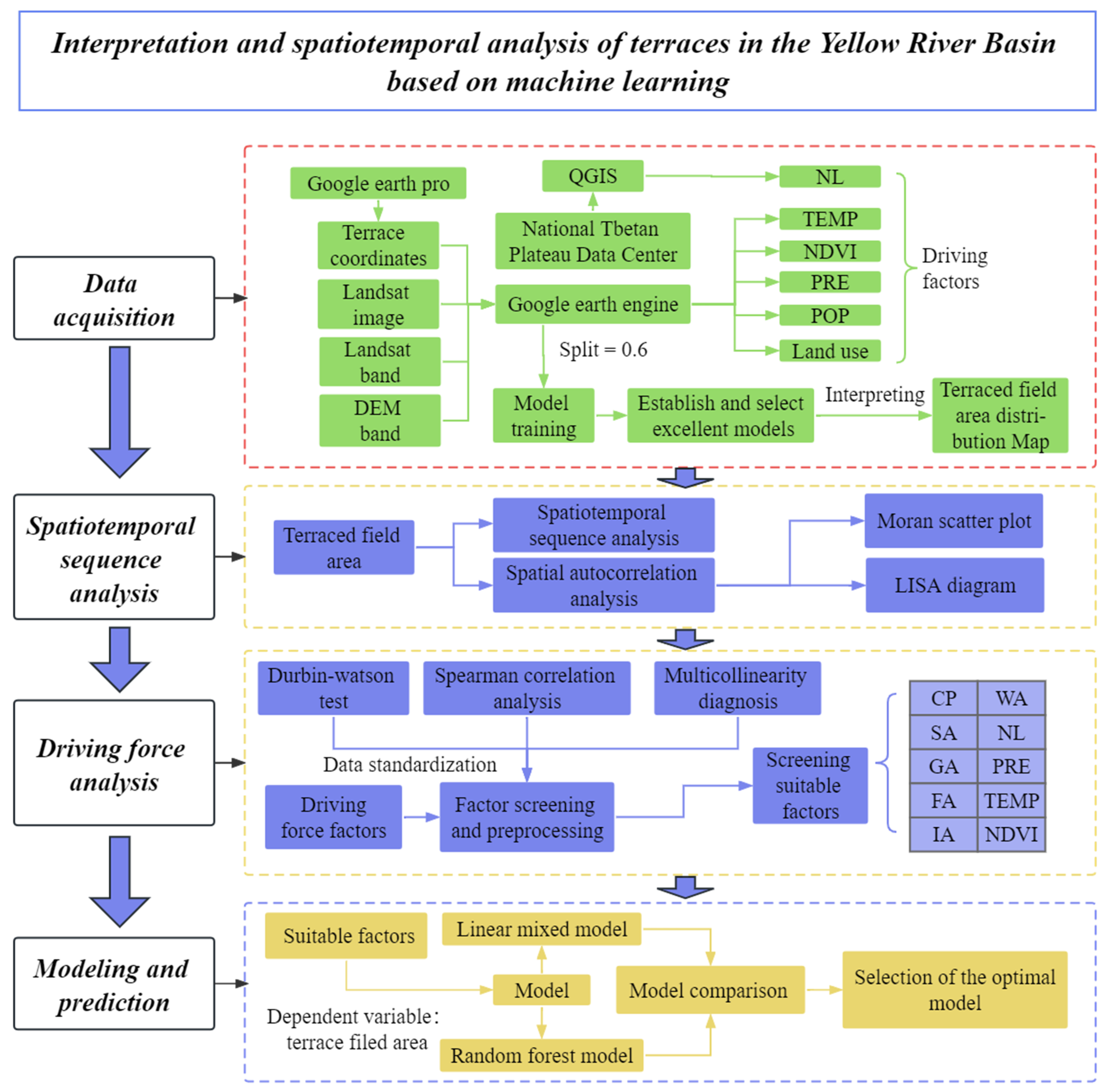
4. Results
4.1. Evaluation of the Interpretation Accuracy of TRAs
4.2. Trend Analysis of TRA Changes Every 5 Years in a 30-Year Period
4.2.1. Analysis of Spatiotemporal Changes
4.2.2. Spatial Autocorrelation Analysis
4.3. Driving Force Analysis
4.3.1. Durbin–Watson Test
4.3.2. Spearman Correlation Analysis
4.3.3. Multicollinearity Diagnosis
4.4. Linear Mixed Model (LMM) Analysis
4.5. Random Forest Model
4.5.1. Optimizing the Model through Variable Importance Assessment
4.5.2. Evaluation of Accuracy Metrics for the Random Forest Model
5. Discussion
5.1. Advantages of Utilizing GEE for Terrace Interpretation and Analyzing Spatiotemporal Variability of TRAs
5.2. Spatiotemporal Variation Patterns of TRAs in the YRB
5.3. Driving Force Factors of TRA Changes in the YRB
6. Conclusions
Author Contributions
Funding
Institutional Review Board Statement
Informed Consent Statement
Data Availability Statement
Conflicts of Interest
References
- Tian, P.; Tian, X.; Geng, R.; Zhao, G.; Yang, L.; Mu, X.; Gao, P.; Sun, W.; Liu, Y. Response of soil erosion to vegetation restoration and terracing on the Loess Plateau. Catena 2023, 227, 107103. [Google Scholar] [CrossRef]
- Fang, H. Effect of soil conservation measures and slope on runoff, soil, TN, and TP losses from cultivated lands in northern China. Ecol. Indic. 2021, 126, 107677. [Google Scholar] [CrossRef]
- Arigaw, A.K.; Bedewi, S.A.; Yohannes, M.D. Sediment yield responses to land use land cover change and developing best management practices in the upper Gidabo dam watershed. Sustain. Water Resour. Manag. 2023, 9, 68. [Google Scholar]
- Jayanta, L.; Anup, D.; Kumar, G.P.; Krishnappa, R.; Rattan, L.; Gandhiji, I.R.; Prasad, N.C.; Utpal, D. Double no-till and rice straw retention in terraced sloping lands improves water content, soil health and productivity of lentil in Himalayan foothills. Soil Tillage Res. 2022, 221, 105381. [Google Scholar]
- Shi, X.; Song, X.; Yang, J.; Zhao, Y.; Yuan, Z.; Zhao, G.; Abbott, L.K.; Zhang, F.; Li, F.-M. Yield benefits from joint application of manure and inorganic fertilizer in a long-term field pea, wheat and potato crop rotation. Field Crops Res. 2023, 294, 108873. [Google Scholar] [CrossRef]
- Wu, D.; Wei, W.; Li, Z.; Zhang, Q. Coupling Effects of Terracing and Vegetation on Soil Ecosystem Multifunctionality in the Loess Plateau, China. Sustainability 2023, 15, 1682. [Google Scholar] [CrossRef]
- Ma, M.; Lei, E.; Wang, T.; Meng, H.; Zhang, W.; Lu, B. Genetic Diversity and Association Mapping of Grain-Size Traits in Rice Landraces from the Honghe Hani Rice Terraces System in Yunnan Province. Plants 2023, 12, 1678. [Google Scholar] [CrossRef]
- Tarolli, P.; Preti, F.; Romano, N. Terraced landscapes: From an old best practice to a potential hazard for soil degradation due to land abandonment. Anthropocene 2014, 6, 10–25. [Google Scholar] [CrossRef]
- Wang, W.; Straffelini, E.; Tarolli, P. Steep-slope viticulture: The effectiveness of micro-water storage in improving the resilience to weather extremes. Agric. Water Manag. 2023, 286, 108398. [Google Scholar] [CrossRef]
- Hopkins, A.J.; Snyder, N.P. Performance evaluation of three DEM-based fluvial terrace mapping methods. Earth Surf. Process. Landf. 2016, 41, 1144–1152. [Google Scholar] [CrossRef]
- Huang, W.; Duan, W.; Nover, D.; Sahu, N.; Chen, Y. An integrated assessment of surface water dynamics in the Irtysh River Basin during 1990–2019 and exploratory factor analyses. J. Hydrol. 2021, 593, 125905. [Google Scholar] [CrossRef]
- Kumar, R.; Nath, A.J.; Nath, A.; Sahu, N.; Pandey, R. Landsat-based multi-decadal spatio-temporal assessment of the vegetation greening and browning trend in the Eastern Indian Himalayan Region. Remote Sens. Appl. Soc. Environ. 2022, 25, 100695. [Google Scholar] [CrossRef]
- Hu, Y.; Duan, W.; Chen, Y.; Zou, S.; Kayumba, P.M.; Sahu, N. An integrated assessment of runoff dynamics in the Amu Darya River Basin: Confronting climate change and multiple human activities, 1960–2017. J. Hydrol. 2021, 603, 126905. [Google Scholar] [CrossRef]
- Yu, M.; Li, Y.; Luo, G.; Yu, L.; Chen, M. Agroecosystem composition and landscape ecological risk evolution of rice terraces in the southern mountains, China. Ecol. Indic. 2022, 145, 109625. [Google Scholar] [CrossRef]
- Yang, J.; Huang, X. The 30 m annual land cover dataset and its dynamics in China from 1990 to 2019. Earth Syst. Sci. Data 2021, 13, 3907–3925. [Google Scholar] [CrossRef]
- Winzeler, H.E.; Owens, P.R.; Kharel, T.; Ashworth, A.; Libohova, Z. Identification and Delineation of Broad-Base Agricultural Terraces in Flat Landscapes in Northeastern Oklahoma, USA. Land 2023, 12, 486. [Google Scholar] [CrossRef]
- Li, F.-B.; Lu, G.-D.; Zhou, X.-Y.; Ni, H.-X.; Xu, C.-C.; Yue, C.; Yang, X.-M.; Feng, J.-F.; Fang, F.-P. Elevation and Land Use Types Have Significant Impacts on Spatial Variability of Soil Organic Matter Content in Hani Terraced Field of Yuanyang County, China. Rice Sci. 2015, 22, 27–34. [Google Scholar]
- Rocha, J.; Duarte, A.; Fabres, S.; Quintela, A.; Serpa, D. Influence of DEM Resolution on the Hydrological Responses of a Terraced Catchment: An Exploratory Modelling Approach. Remote Sens. 2023, 15, 169. [Google Scholar] [CrossRef]
- Zhang, Y.; Wang, Y.; Sun, S.; Chen, X. Quantifying Interregional Flows of Ecosystem Services to Enhance Water Security in the Yellow River Basin, China. J. Water Resour. Plan. Manag. 2023, 149, 04023018. [Google Scholar] [CrossRef]
- Wang, L.; Yao, W.; Xiao, P.; Hou, X. The Spatiotemporal Characteristics of Flow-Sediment Relationships in a Hilly Watershed of the Chinese Loess Plateau. Int. J. Environ. Res. Public Health 2022, 19, 9089. [Google Scholar] [CrossRef]
- Sun, P. The Effect of a Small Initial Distortion of the Basic Flow on the Subcritical Transition in Plane Poiseuille Flow. Q. Appl. Math. 2001, 59, 667–699. [Google Scholar] [CrossRef][Green Version]
- Wang, X.; Shi, S.; Zhao, X.; Hu, Z.; Hou, M.; Xu, L. Detecting Spatially Non-Stationary between Vegetation and Related Factors in the Yellow River Basin from 1986 to 2021 Using Multiscale Geographically Weighted Regression Based on Landsat. Remote Sens. 2022, 14, 6276. [Google Scholar] [CrossRef]
- Rong, T.; Zhang, P.; Li, G.; Wang, Q.; Zheng, H.; Chang, Y.; Zhang, Y. Spatial correlation evolution and prediction scenario of land use carbon emissions in the Yellow River Basin. Ecol. Indic. 2023, 154, 110701. [Google Scholar] [CrossRef]
- Fan, W.; Song, X.; Liu, M.; Shan, B.; Ma, M.; Liu, Y. Spatio-temporal evolution of resources and environmental carrying capacity and its influencing factors -A case study of shandong peninsula urban agglomeration. Environ. Res. 2023, 234, 116469. [Google Scholar] [CrossRef] [PubMed]
- Wang, J.; Wang, J.; Zhang, J. Spatial distribution characteristics of natural ecological resilience in China. J. Environ. Manag. 2023, 342, 118133. [Google Scholar] [CrossRef] [PubMed]
- Qi, H.; Shen, X.; Long, F.; Liu, M.; Gao, X. Spatial-temporal characteristics and influencing factors of county-level carbon emissions in Zhejiang Province, China. Environ. Sci. Pollut. Res. Int. 2022, 30, 10136–10148. [Google Scholar] [CrossRef] [PubMed]
- Xiong, L.; Wang, F.; Cheng, B.; Yu, C. Identifying factors influencing the forestry production efficiency in Northwest China. Resour. Conserv. Recycl. 2018, 130, 12–19. [Google Scholar] [CrossRef]
- Yang, Q.; Pu, L.; Jiang, C.; Gong, G.; Tan, H.; Wang, X.; He, G. Unveiling the spatial-temporal variation of urban land use efficiency of Yangtze River Economic Belt in China under carbon emission constraints. Front. Environ. Sci. 2023, 10, 1096087. [Google Scholar] [CrossRef]
- Wu, Y.H. Analysis on Spatial Difference of the Rural Resident’s per Capita Net Income in Qinhuangdao City Based on ESDA. Adv. Mater. Res. 2014, 955, 3893–3898. [Google Scholar] [CrossRef]
- Zhu, M.; Tang, H.; Elahi, E.; Khalid, Z.; Wang, K.; Nisar, N. Spatial-Temporal Changes and Influencing Factors of Ecological Protection Levels in the Middle and Lower Reaches of the Yellow River. Sustainability 2022, 14, 14888. [Google Scholar] [CrossRef]
- Gorelick, N.; Hancher, M.; Dixon, M.; Ilyushchenko, S.; Thau, D.; Moore, R. Google Earth Engine: Planetary-scale geospatial analysis for everyone. Remote Sens. Environ. 2017, 202, 18–27. [Google Scholar] [CrossRef]
- Cui, J.; Guo, Y.; Xu, Q.; Li, D.; Chen, W.; Shi, L.; Ji, G.; Li, L. Extraction of Information on the Flooding Extent of Agricultural Land in Henan Province Based on Multi-Source Remote Sensing Images and Google Earth Engine. Agronomy 2023, 13, 355. [Google Scholar] [CrossRef]
- Paulina, Z.; Ewa, D.; Kamil, M. Accuracy of the evaluation of forest areas based on Landsat data using free software. Folia For. Pol. 2023, 65, 76–85. [Google Scholar]
- Cao, B.; Yu, L.; Naipa, V.; Ciais, P.; Li, W.; Zhao, Y.; Wei, W.; Chen, D.; Liu, Z.; Gong, P. A 30 m terrace mapping in China using Landsat 8 imagery and digital elevation model based on the Google Earth Engine. Earth Syst. Sci. Data 2021, 13, 2437–2456. [Google Scholar] [CrossRef]
- Yang, J.; Xu, J.; Zhou, Y.; Zhai, D.; Chen, H.; Li, Q.; Zhao, G. Paddy Rice Phenological Mapping throughout 30-Years Satellite Images in the Honghe Hani Rice Terraces. Remote Sens. 2023, 15, 2398. [Google Scholar] [CrossRef]
- Raza, M.; Hussain, F.K.; Hussain, O.K.; Zhao, M.; ur Rehman, Z. A comparative analysis of machine learning models for quality pillar assessment of SaaS services by multi-class text classification of users’ reviews. Future Gener. Comput. Syst. 2019, 101, 341–371. [Google Scholar] [CrossRef]
- Kynkäänniemi, T.; Karras, T.; Laine, S.; Lehtinen, J.; Aila, T. Improved Precision and Recall Metric for Assessing Generative Models. Adv. Neural Inf. Process. Syst. 2019, 32. [Google Scholar] [CrossRef]
- Pepe, G.; Mandarino, A.; Raso, E.; Scarpellini, P.; Brandolini, P.; Cevasco, A. Investigation on farmland abandonment of terraced slopes using multitemporal data sources comparison and its implication on hydro-geomorphological processes. Water 2019, 11, 1552. [Google Scholar] [CrossRef]
- Yang, K.; Lu, C. Evaluation of land-use change effects on runoff and soil erosion of a hilly basin—The Yanhe River in the Chinese Loess Plateau. Land Degrad. Dev. 2018, 29, 1211–1221. [Google Scholar] [CrossRef]
- Claessens, L.; Stoorvogel, J.; Antle, J. Exploring the impacts of field interactions on an integrated assessment of terraced crop systems in the Peruvian Andes. J. Land Use Sci. 2010, 5, 259–275. [Google Scholar] [CrossRef]
- Dong, S.; Xin, L.; Li, S.; Xie, H.; Zhao, Y.; Wang, X.; Li, X.; Song, H.; Lu, Y. Extent and spatial distribution of terrace abandonment in China. J. Geogr. Sci. 2023, 33, 1361–1376. [Google Scholar] [CrossRef]
- Wang, S.-Y.; Liu, J.-S.; Ma, T.-B. Dynamics and changes in spatial patterns of land use in Yellow River Basin, China. Land Use Policy 2010, 27, 313–323. [Google Scholar] [CrossRef]
- Mantena, S.; Mahammood, V.; Rao, K.N. Prediction of soil salinity in the Upputeru river estuary catchment, India, using machine learning techniques. Environ. Monit. Assess. 2023, 195, 1006. [Google Scholar] [CrossRef] [PubMed]
- Zhou, J.; Li, C.; Chu, X.; Luo, C. Is Cultivated Land Increased by Land Consolidation Sustainably Used in Mountainous Areas? Land 2022, 11, 2236. [Google Scholar] [CrossRef]
- Yu, H.; Song, G.; Li, T.; Liu, Y. Spatial Pattern Characteristics and Influencing Factors of Green Use Efficiency of Urban Construction Land in Jilin Province. Complexity 2020, 2020, 5637530. [Google Scholar] [CrossRef]
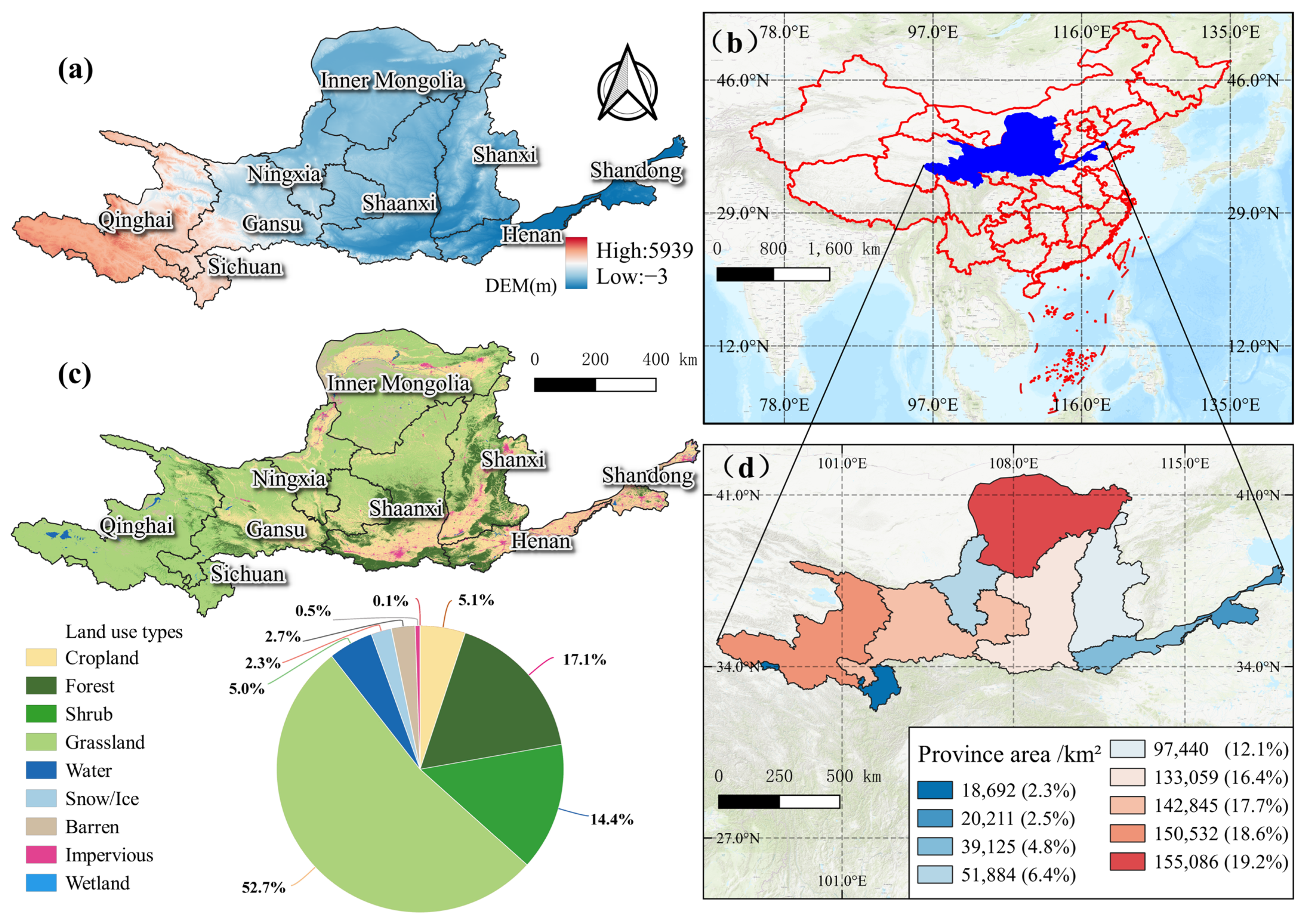
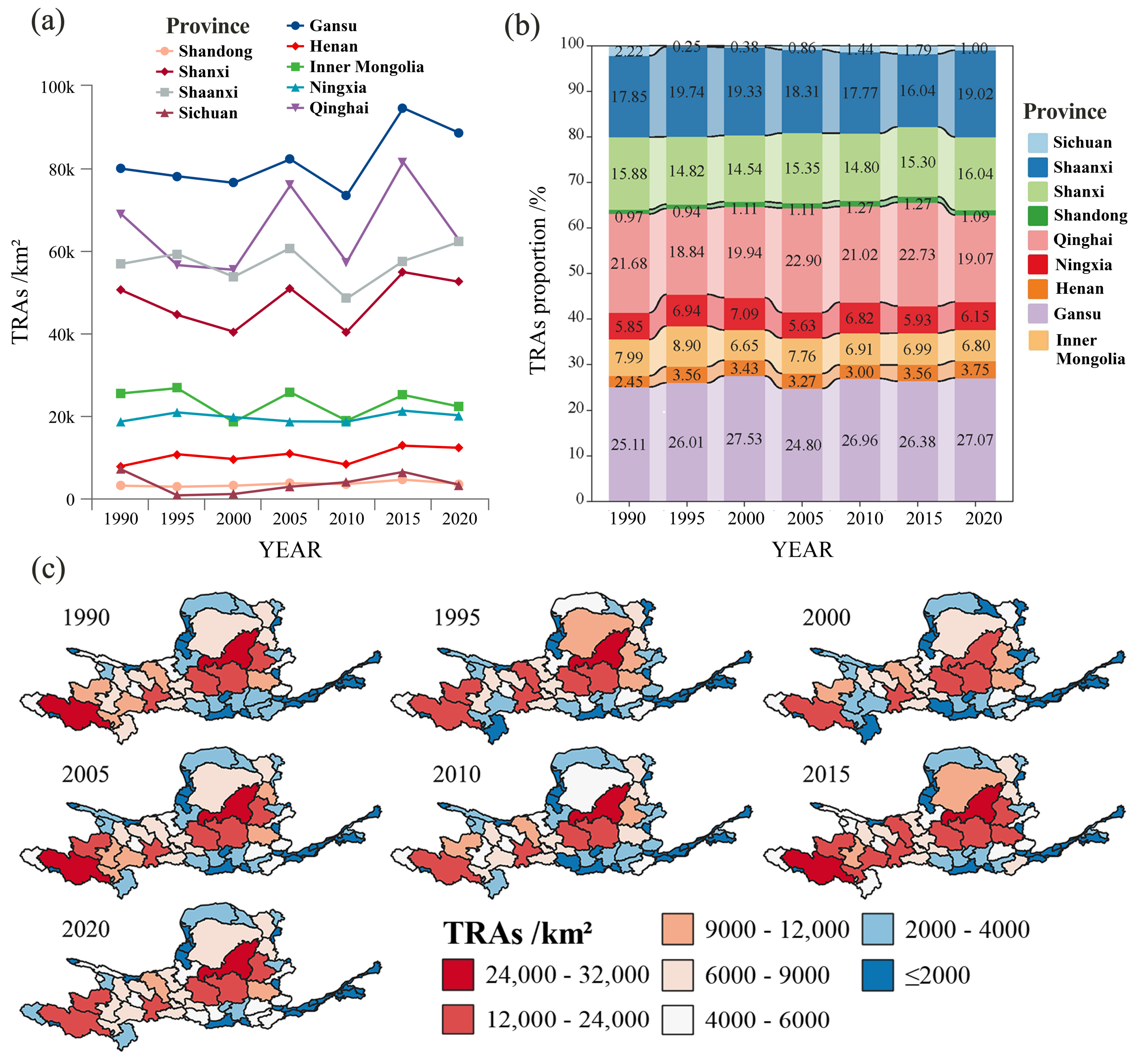
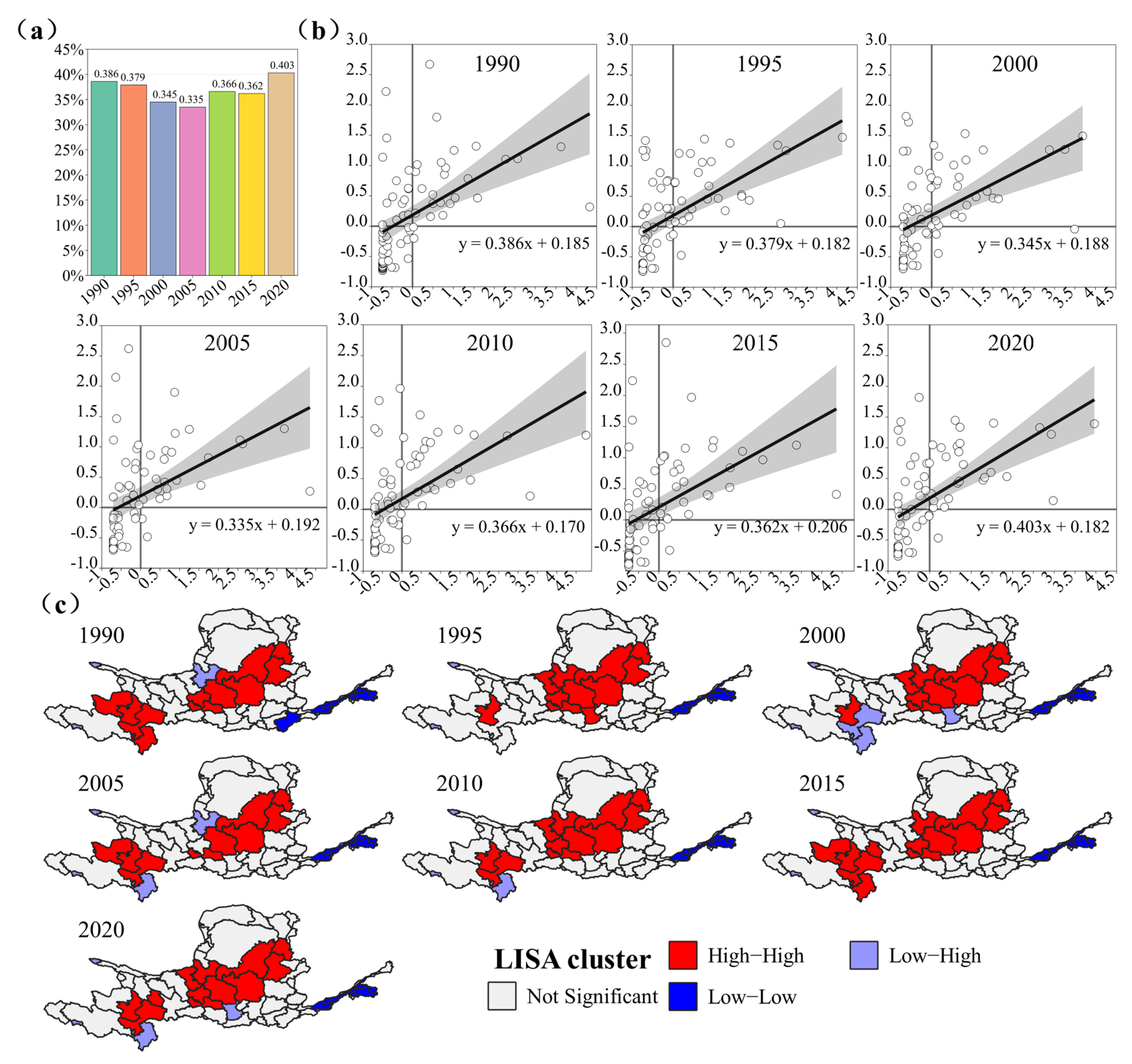
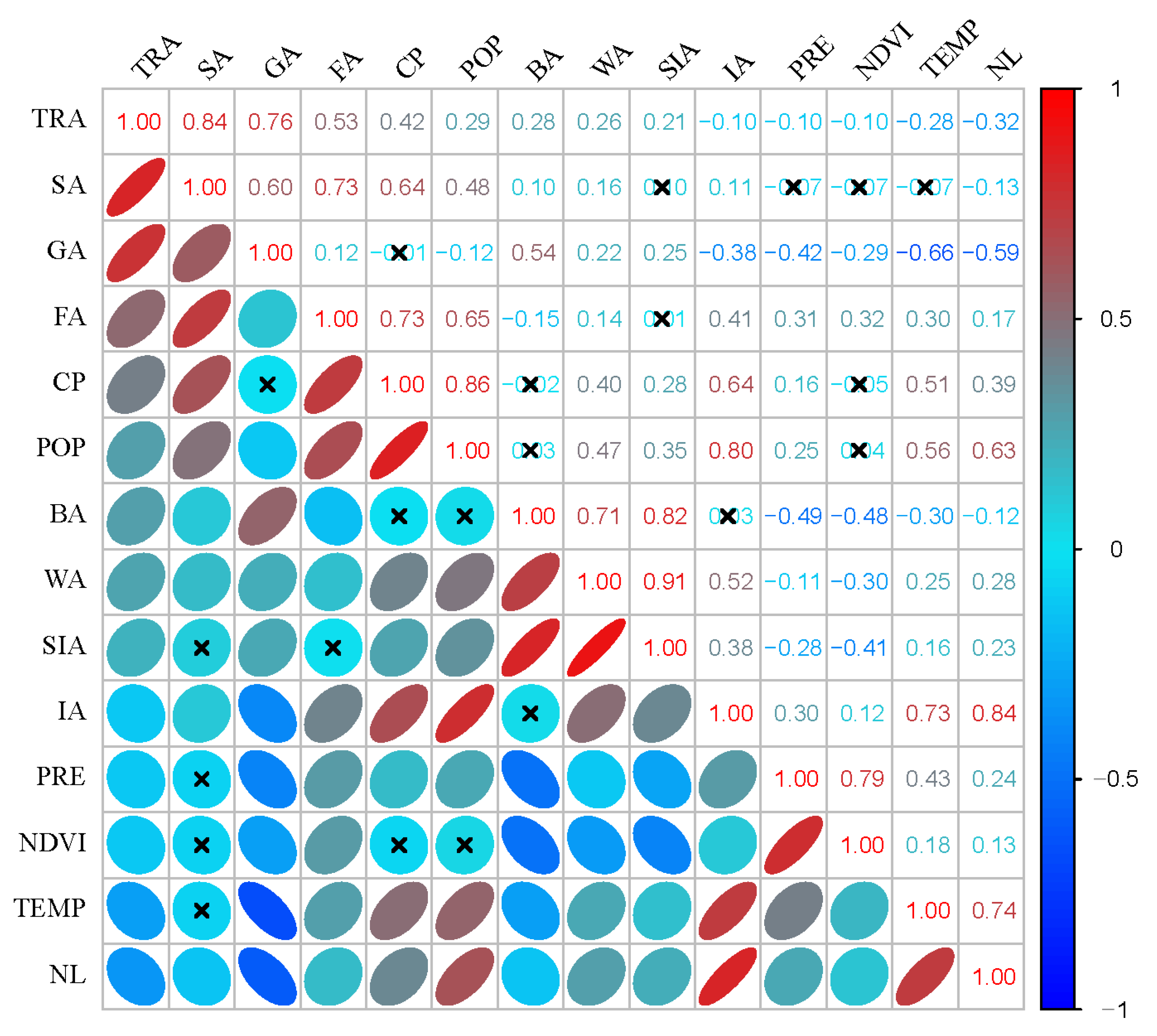
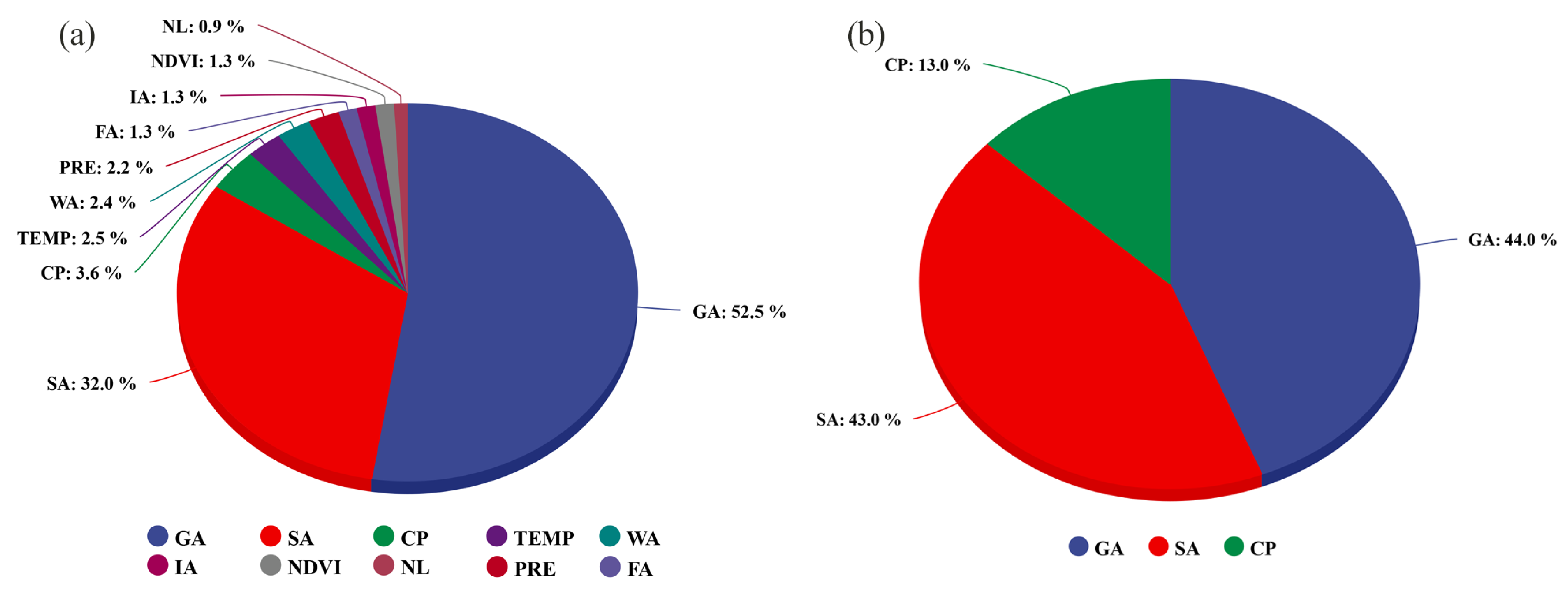
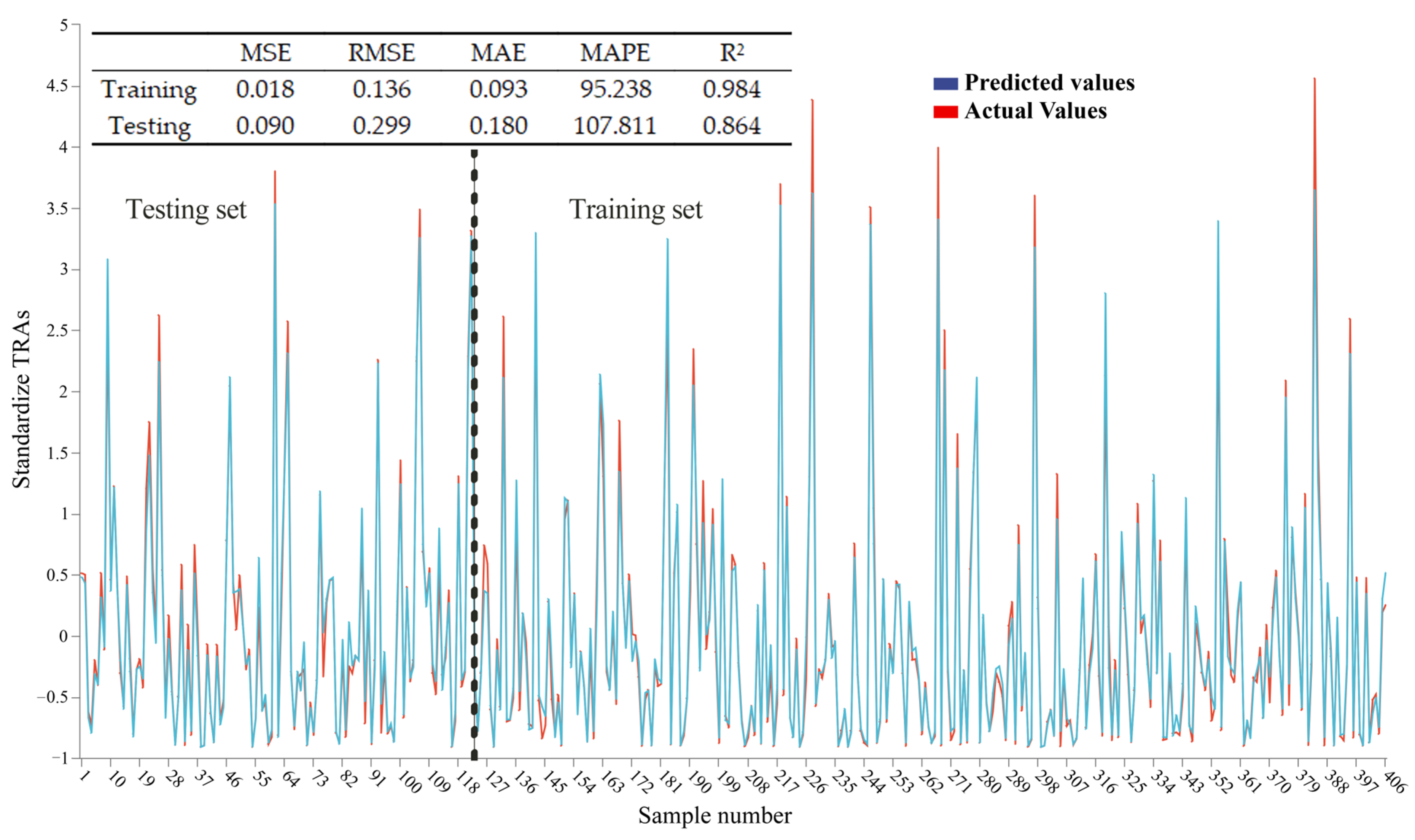

| Value (Abbreviation) | Unit | Data Source | |
|---|---|---|---|
| 1 | Terrace-field areas (TRAs) | km2 | This study |
| 2 | Normalized difference vegetation index (NDVI) | / | USGS Landsat 5 Level 2, Collection 2, Tier 1 (1990–2010) https://earthengine.google.com/, accessed on 5 June 2022 |
| USGS Landsat 8 Level 2, Collection 2, Tier 1 (2015–2020) https://earthengine.google.com/, accessed on 5 June 2022 | |||
| 3 | Forest (FA) | km2 | CLCD from Jie Yang; Xin Huang https://doi.org/10.5281/zenodo.5816591/, accessed on 5 August 2022 |
| 4 | Shrub (SA) | km2 | |
| 5 | Grassland (GA) | km2 | |
| 6 | Water (WA) | km2 | |
| 7 | Snow/ice (SIA) | km2 | |
| 8 | Barren (BA) | km2 | |
| 9 | Cropland (CP) | km2 | |
| 10 | Impervious (IA) | km2 | |
| 11 | Precipitation (PRE) | mm | Climate Hazards Group InfraRed Precipitation with Station Data https://www.chc.ucsb.edu/data/chirpson/, accessed on 5 August 2022 |
| 12 | Temperature (TEMP) | °C | ERA5 Monthly Aggregates https://www.ecmwf.int/, accessed on 5 August 2022 |
| 13 | Population (POP) | / | National Science & Technology Infrastructure of China https://www.worldpop.org/, accessed on 27 June 2022 |
| 14 | Night light (NL) | / | Third Pole Environment Data Center http://data.tpdc.ac.cn/, accessed on 25 June 2022 |
| Year | Confusion Matrix | Overall Accuracy | Kappa | Precision | Recall | F1 |
|---|---|---|---|---|---|---|
| 1990 | [[90, 4], [19, 98]] | 0.89 | 0.78 | 0.96 | 0.83 | 0.89 |
| 1995 | [[94, 1], [12, 106]] | 0.93 | 0.87 | 0.99 | 0.89 | 0.94 |
| 2000 | [[108, 4], [18, 92]] | 0.90 | 0.80 | 0.96 | 0.86 | 0.91 |
| 2005 | [[67, 1], [7, 87]] | 0.95 | 0.89 | 0.99 | 0.91 | 0.95 |
| 2010 | [[70, 0], [11, 133]] | 0.94 | 0.88 | 1.00 | 0.86 | 0.93 |
| 2015 | [[67, 1], [15, 103]] | 0.91 | 0.82 | 0.99 | 0.82 | 0.90 |
| 2020 | [[64, 1], [9, 86]] | 0.90 | 0.87 | 0.98 | 0.88 | 0.92 |
| Average value | 0.92 | 0.84 | 0.98 | 0.86 | 0.92 | |
| Province | Coefficient of Variation | |
|---|---|---|
| 1 | Shaanxi | 10.65% |
| 2 | Gansu | 10.69% |
| 3 | Shandong | 16.09% |
| 4 | Shanxi | 17.63% |
| 5 | Ningxia | 19.99% |
| 6 | Qinghai | 22.37% |
| 7 | Inner Mongolia | 29.44% |
| 8 | Henan | 30.17% |
| 9 | Sichuan | 41.87% |
| R | R2 | Adjusted R2 | Errors in Standard Estimates | Durbin–Watson Test |
|---|---|---|---|---|
| 0.939 | 0.881 | 0.877 | 2078.984 | 0.814 |
| Model | Unstandardized Coefficients | Standardized Coefficients | t | p | Collinearity Statistics | ||
|---|---|---|---|---|---|---|---|
| B | SE | Beta | Tolerance | VIF | |||
| (Constant) | −698.683 | 435.9 | −1.603 | 0.110 | |||
| CP | 5.664 | 0.728 | 0.243 | 7.783 | 0.000 | 0.314 | 3.185 |
| FA | −0.383 | 0.698 | −0.015 | −0.549 | 0.584 | 0.401 | 2.493 |
| SA | 18.227 | 1.394 | 0.415 | 13.079 | 0.000 | 0.305 | 3.281 |
| GA | 4.467 | 0.169 | 0.834 | 26.432 | 0.000 | 0.308 | 3.248 |
| WA | −30.728 | 2.105 | −0.382 | −14.595 | 0.000 | 0.448 | 2.231 |
| IA | −7.970 | 7.819 | −0.036 | −1.019 | 0.309 | 0.251 | 3.979 |
| NL | 0.933 | 0.513 | 0.061 | 1.82 | 0.069 | 0.274 | 3.647 |
| PRE | 0.016 | 1.122 | 0.000 | 0.014 | 0.989 | 0.284 | 3.516 |
| TEMP | 8.166 | 29.966 | 0.008 | 0.273 | 0.785 | 0.373 | 2.680 |
| NDVI | −578.482 | 1329.254 | −0.015 | −0.435 | 0.664 | 0.259 | 3.862 |
| Coefficient | Estimation | Standard Error | Degrees of Freedom | t | Significance | Confidence Interval | |
|---|---|---|---|---|---|---|---|
| Lower Limit | Upper Limit | ||||||
| Intercept | −549.804 | 831.325 | 92.159 | −0.661 | 0.510 | −2200.850 | 1101.242 |
| CP | 6.020 | 1.346 | 118.460 | 4.472 | 0.000 | 3.354 | 8.685 |
| SA | 7.613 | 2.061 | 227.015 | 3.694 | 0.000 | 3.552 | 11.675 |
| GA | 1.040 | 0.369 | 90.456 | 2.816 | 0.006 | 0.306 | 1.774 |
| FA | 1.898 | 1.996 | 58.803 | 0.951 | 0.346 | −2.096 | 5.894 |
| IA | 7.572 | 8.877 | 205.494 | 0.853 | 0.395 | −9.930 | 25.076 |
| NL | 0.512 | 0.715 | 194.384 | 0.716 | 0.475 | −0.898 | 1.923 |
| NDVI | −726.050 | 1420.014 | 285.714 | −0.511 | 0.610 | −3521.070 | 2068.965 |
| PRE | −0.369 | 1.043 | 308.927 | −0.354 | 0.724 | −2.422 | 1.683 |
| TEMP | −13.734 | 61.226 | 134.584 | −0.224 | 0.823 | −134.824 | 107.355 |
| WA | −0.139 | 4.233 | 97.060 | −0.033 | 0.974 | −8.541 | 8.262 |
| Coefficient | Estimation | Standard Error | Degrees of Freedom | t | Significance | Confidence Interval | |
|---|---|---|---|---|---|---|---|
| Lower Limit | Upper Limit | ||||||
| Intercept | −759.448 | 543.901 | 51.552 | −1.396 | 0.169 | −1851.090 | 332.197 |
| CP | 5.796 | 1.191 | 118.419 | 4.869 | 0.000 | 3.439 | 8.154 |
| SA | 8.641 | 1.717 | 197.685 | 5.032 | 0.000 | 5.254 | 12.027 |
| GA | 1.216 | 0.311 | 61.801 | 3.913 | 0.000 | 0.595 | 1.837 |
Disclaimer/Publisher’s Note: The statements, opinions and data contained in all publications are solely those of the individual author(s) and contributor(s) and not of MDPI and/or the editor(s). MDPI and/or the editor(s) disclaim responsibility for any injury to people or property resulting from any ideas, methods, instructions or products referred to in the content. |
© 2023 by the authors. Licensee MDPI, Basel, Switzerland. This article is an open access article distributed under the terms and conditions of the Creative Commons Attribution (CC BY) license (https://creativecommons.org/licenses/by/4.0/).
Share and Cite
Li, Z.; Tian, J.; Ya, Q.; Feng, X.; Wang, Y.; Ren, Y.; Wu, G. Interpretation and Spatiotemporal Analysis of Terraces in the Yellow River Basin Based on Machine Learning. Sustainability 2023, 15, 15607. https://doi.org/10.3390/su152115607
Li Z, Tian J, Ya Q, Feng X, Wang Y, Ren Y, Wu G. Interpretation and Spatiotemporal Analysis of Terraces in the Yellow River Basin Based on Machine Learning. Sustainability. 2023; 15(21):15607. https://doi.org/10.3390/su152115607
Chicago/Turabian StyleLi, Zishuo, Jia Tian, Qian Ya, Xuejuan Feng, Yingxuan Wang, Yi Ren, and Guowei Wu. 2023. "Interpretation and Spatiotemporal Analysis of Terraces in the Yellow River Basin Based on Machine Learning" Sustainability 15, no. 21: 15607. https://doi.org/10.3390/su152115607
APA StyleLi, Z., Tian, J., Ya, Q., Feng, X., Wang, Y., Ren, Y., & Wu, G. (2023). Interpretation and Spatiotemporal Analysis of Terraces in the Yellow River Basin Based on Machine Learning. Sustainability, 15(21), 15607. https://doi.org/10.3390/su152115607





